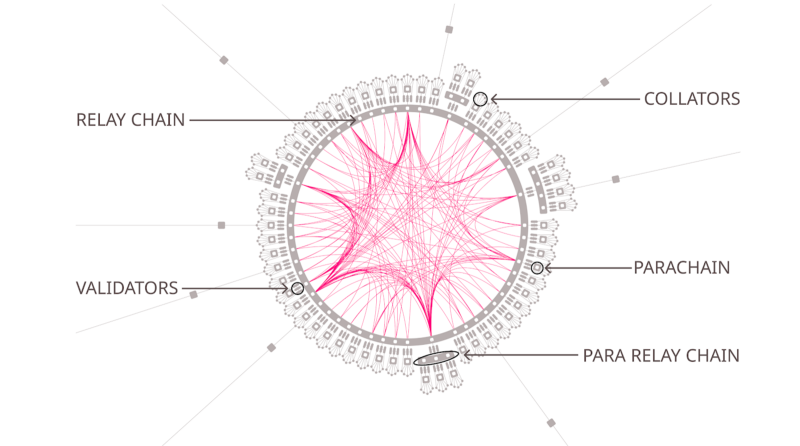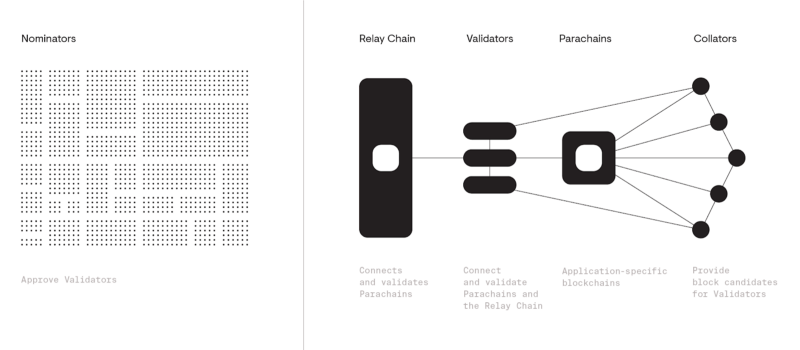Polkadot: a global network of interoperable chains
Polkadot Quick Guide & Overview
Hi Readers👩💻,
On May 26th, 2020, after three years of anticipation, the Web3 Foundation launched Polkadot’s initial version. This network is a sharded protocol that allows decentralized blockchain networks to operate together efficiently and at scale.
In our article about Blockchain Interoperability, we’ve discussed how, with Polkadot’s implementation, all connected blockchains will be able to transmit value, including messages or any data, in a way that they can trust one another. Polkadot gives peer-to-peer applications, organizations, businesses, economies the agency required to form, grow, govern themselves, and interact without the need for the centralized institutions that we are forced to place our trust in today.
🧐 Part 1 — What is Polkadot?
Polkadot is a global network of interoperable chains, also known as a sharded blockchain. That means it connects several chains to create a unified network for blockchain to process in parallel and exchange data with reliable security between chains. Using Polkadot, you’re able to communicate with other existing chains that have been ported on the Polkadot layer. You can also create new chains and can send transactions as well as messages to each other.
Ultimately, Polkadot enables the creation of networks of blockchains. However, one chain does not fit all applications in the network of blockchains. You can have various chains, each with their characteristics and parameters adapted to the problem they are solving.
By parallelizing the workload, meaning if, for example, one chain is overloaded, transactions can run in parallel on another chain (a parachain). Then their history re-imported on the mainchain (the relay chain). Polkadot can solve major throughput issues that so far have hindered the decentralization application development. With Polkadot’s design, applications from DeFi (decentralized finance) and energy to the Internet of Things (IoT) and gaming can thrive on the network. It offers heterogeneous sharding, scalability, upgradeability, transparent governance, and cross-chain composability, which are distinct advantages over existing networks.
So, what are the critical characteristics of Polkadot? The first and most often mentioned one is interoperability, which we discussed above. The second characteristic is horizontal scalability, and architecture with multiple interoperable chains running in parallel, making the network theoretically infinitely scalable.
Governance on Polkadot works through the community that can propose and vote on decisions that impact the network’s future, like many Proof-of-Stake variation networks. DOT holders (Polkadot’s native digital asset) can contribute to the future of the network in several ways, like proposing, prioritizing a public referendum (proposals), voting on the referendum, voting for validators (council members) or becoming a validator.
Furthermore, Polkadot works with the shared security model. Builders on the blockchain can plug-in to the original security model so that developers don’t have to worry about it. Meaning different systems share the same pool of validators, allowing the whole system to move together in one step if there is one transaction on a parachain, and improves trust within the entire ecosystem.
Another exciting aspect of Polkadot is that it can easily upgrade its entire network without splitting the community or having to split the chain. Meaning, as the network moves from block 98 to 99, to 100, the update then appears, and the entire network has agreed on this; it will continue with block 101 without having to worry about forking.
📖 Part 2 — The Story Behind Polkadot
Polkadot was created in 2016 by Gavin Wood, co-founder and initial CTO of Ethereum. In January 2016, Gavin announced its intention to leave Ethereum and decided to focus on a new venture that would achieve its vision of a truly decentralized internet: Web 3.0.
In November 2016, the first whitepaper of Polkadot was published. Following that, in June 2017, the Web3 Foundation was created, with the role to develop technologies and applications in the fields of decentralized web software protocols. Since then, Polkadot raised various rounds of fundings (including one affected by the Parity wallet hack) for more than $140m.
Who’s behind Polkadot? The Web3 Foundation is the primary entity behind the Polkadot project; it acts as treasurer and council for Polkadot and ensures the development of the project and its ecosystem. Web3 does not only back Polkadot, but also other protocols such as Kusama (Polkadot’s experimental network), a decentralized messaging protocol, community events (Web3 summit), and funds other protocols as well such as Ethereum, where a lot of team members are from.
Web3 contracted about five development teams to help build the protocol: Parity Technologies, Chainsafe Systems, Soramitsu, OpenNetSys, and Polkadot JS.

🪐 Part 3 — The Ecosystem

A world running on Polkadot

Polkadot is a global network of blockchain designed around crucial components:
- Relay chain: in charge of checking the validity of all the parachains and ensuring they operate correctly and securing them. Anyone can connect their chain to the Polkadot network and benefit from this shared security and interact with the other strings.
- Validators: Staked full nodes that are responsible for verifying and adding blocks to the relay chain. They can also be fishermen.
- Parachains: Parachains are application-specific blockchains built to interact with Polkadot. A parachain could be, for example, a privacy coin connecting to the network, a Dapp with its specific chain, an oracle chain, or a smart contract focused chain. It attaches to the security provided by a relay chain and its validator pool rather than providing its own.
- Collators: Bundle (collate) transactions on the parachain they monitor into blocks and send a proof of this block to validators. They can also be fishermen.
- Nominators: In Polkadot’s Nominated Proof-of-Stake (NPoS) consensus algorithm, nominators elect validators by delegating their voting power. They share the risks and rewards of maintaining the network decentralized and secure.
- Fishermen: Fishermen monitor bad behaviors, if able to prove invalid block, whoever submitted that block will have their DOTs slashed and given to the Fishermen. The latter will receive part of the staked DOTs from the malicious actor. This role may be filled by validators and collators, expected to police themselves for a share of the slashing rewards in case of misbehaviors.
- Solo-chains with Bridge: Solo-chains are completely sovereign chains such as Ethereum and can be bridged into the Polkadot network to communicate with its various blockchains, a bit like sidechains.
💰 Part 4 — The Token
DOT is the native digital asset of the Polkadot Network. DOT serves four main functions within the ecosystem: providing governance, operating in the network, creating parachains by bonding DOTs, paying fees, and ferrying messages across parachains.
In the Autumn of 2017, an initial sale of 5 million DOTs was made. Before the launch of the Polkadot genesis block, it was anticipated that 10 million DOTs would be a part of it. Currently, as of the 4th of June 2020, the total issuance of DOTs is 1.5 million. With that said, these are the specifics of the token:
- The current annual reward rate is set at 20% with a lock-up period of 28 days, according to Stakingrewards.
- The current market cap. on June 3rd, 2020 is 1,389,300,000 USD.
More Information & Sources
DISCLAIMER: This is not financial advice. Staking, delegation, and cryptocurrencies involve a high degree of risk, and there is always the possibility of loss, including the loss of all staked digital assets. Additionally, delegators are at risk of slashing in case of security or liveness faults on some protocols. We advise you to do your due diligence before choosing a validator.


Join the conversation